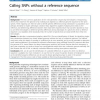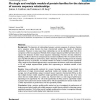1112 search results - page 118 / 223 » Spatio-Temporal Alignment of Sequences |
BMCBI
2010
13 years 9 months ago
2010
Background: The most common application for the next-generation sequencing technologies is resequencing, where short reads from the genome of an individual are aligned to a refere...
BMCBI
2010
13 years 9 months ago
2010
Background: The classification of protein sequences using string algorithms provides valuable insights for protein function prediction. Several methods, based on a variety of diff...
BMCBI
2006
2006
On single and multiple models of protein families for the detection of remote sequence relationships
13 years 9 months ago
Background: The detection of relationships between a protein sequence of unknown function and a sequence whose function has been characterised enables the transfer of functional a...
BMCBI
2005
13 years 9 months ago
2005
Background: With the exponential increase in genomic sequence data there is a need to develop automated approaches to deducing the biological functions of novel sequences with hig...
CIVR
2009
Springer
14 years 3 months ago
2009
Springer
Sequence matching techniques are effective for comparing two videos. However, existing approaches suffer from demanding computational costs and thus are not scalable for large-sca...


